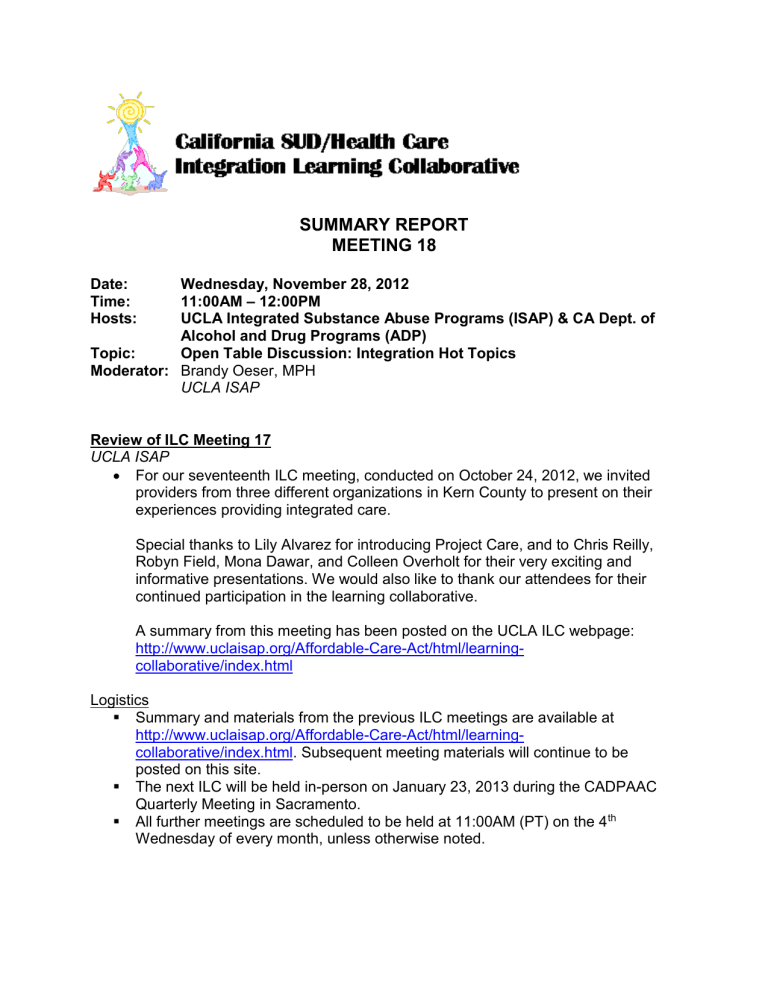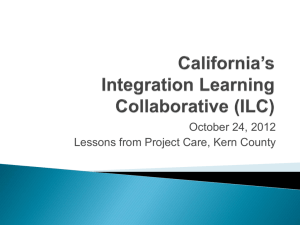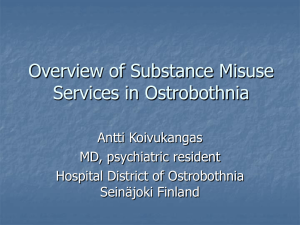Minutes/Summary - UCLA Integrated Substance Abuse Programs

SUMMARY REPORT
MEETING 18
Date:
Time:
Hosts:
Wednesday, November 28, 2012
11:00AM
– 12:00PM
UCLA Integrated Substance Abuse Programs (ISAP) & CA Dept. of
Alcohol and Drug Programs (ADP)
Topic: Open Table Discussion: Integration Hot Topics
Moderator: Brandy Oeser, MPH
UCLA ISAP
Review of ILC Meeting 17
UCLA ISAP
For our seventeenth ILC meeting, conducted on October 24, 2012, we invited providers from three different organizations in Kern County to present on their experiences providing integrated care.
Special thanks to Lily Alvarez for introducing Project Care, and to Chris Reilly,
Robyn Field, Mona Dawar, and Colleen Overholt for their very exciting and informative presentations. We would also like to thank our attendees for their continued participation in the learning collaborative.
A summary from this meeting has been posted on the UCLA ILC webpage: http://www.uclaisap.org/Affordable-Care-Act/html/learningcollaborative/index.html
Logistics
Summary and materials from the previous ILC meetings are available at http://www.uclaisap.org/Affordable-Care-Act/html/learningcollaborative/index.html
. Subsequent meeting materials will continue to be posted on this site.
The next ILC will be held in-person on January 23, 2013 during the CADPAAC
Quarterly Meeting in Sacramento.
All further meetings are scheduled to be held at 11:00AM (PT) on the 4 th
Wednesday of every month, unless otherwise noted.
ILC Meeting 18 Topic:
Open Table Discussion: Integration Hot Topics
Topic Introduction – Brandy Oeser, MPH, UCLA ISAP
Today’s learning collaborative is an open table discussion on popular themes brought up in a recent survey conducted by UCLA on the topic of integration.
Our goal is to provide an opportunity for participants to share their experiences regarding barriers to integration and to collectively discuss how others have navigated through some of the same issues.
Summary of ILC Meeting 18:
UCLA has recently completed a follow-up to our 2010 Integration Survey. Over 50 counties responded this time, giving us a response rate of about 86%
– thank you to all who helped out! We are now getting the results ready to present at the next CADPAAC
Quarterly Meeting.
Our initial review of the responses has revealed some common barriers and themes.
For this ILC, we will be turning the tables and opening up the discussion to get more input from our participants.
We will discuss:
1. Partnering with primary care
2. SBIRT in primary care settings: confidentiality concerns
3. Documentation and EHR implementation
4. Workforce capacity
5. Financial barriers
6. Additional needs/concerns
1. Partnering with Primary Care
Brandy Oeser (UCLA): This was one of the most commonly reported concerns – about 56% of survey respondents found forming effective partnerships between
SUD and PC providers to be a significant challenge.
o Dan Peters (San Bernardino County):
Positive experiences forming partnerships between doctors and clinic staff at the McKee teaching clinic in San Bernardino County:
Early on, met with doctors at the main county hospital. Presented at doctors’ meetings on the benefits of embedded BH services for clinic patients.
Communicated regularly with doctors. Made rounds on a daily basis in the clinic, where BH is directly embedded.
Verbal updates on patients and charting information from BH seems to be helpful for doctors.
Doctors have come to depend on the clinic’s staff to take over certain services when the clinic waiting room is full. o Wayne Sugita (Los Angeles County):
Experiences trying to partner with community-based health clinics:
Assembled a workgroup of SUD providers to present and explore partnering opportunities at the Community Clinics Association of Los
Angeles, a fairly large provider association of all the community health clinics in the county.
Workgroup ended up being referred to the behavioral health subcommittee; felt they were “preaching to the choir” because all of their clinics already have embedded BH services. But meeting with the subcommittee got their foot in the door.
Workgroup found that m any small health clinics’ problems paralleled issues faced by smaller SUD programs (weak IT infrastructure, pen-andpaper patient files, misconceptions about SUD/MH issues and the general
SUD patient population).
Continuing to meet and exchange information, but it’s been more challenging than expected.
Darren Urada (UCLA): What arguments seemed to resonate the most with primary care when describing the benefits of BH services? For example, saving costs, improving care, taking problematic patients off the doctors’ hands? o Dan: The biggest concern for doctors was providing good patient care. Busy doctors appreciate the ability to give their patients continuing care by referring them to the clinic’s BH staff when they can’t properly address patients’ needs
(not enough time/expertise/etc.) – doctors find this extra help to be very valuable.
Because the BH staff are directly embedded in the clinic, they can address patients’ BH issues and also help to alleviate doctors’ often heavy caseloads – while also clipping along at the same pace as the rest of the clinic. That was a big sell: that BH could take the patients, give immediate feedback through charting (verbal too if needed), and thereby help doctors provide better care to patients.
The biggest selling point for on-site BH presence is that patients can get
connected to all available care, not just the medical part. o Wayne: Agree with Dan. Doctors were very interested in having BH workers onsite.
Some of the challenges included: getting enough clinic space for co-located BH staff and finding the resources to fund things like computers and phones for the staff. o Darren: How have you managed to fund these services?
Wayne: Nothing stable right now; LA County is working on it.
Dan: San Bernardino too. We have two offices that are located inside the doctors’ clinic. Nobody knows how to bill for these things yet – only basic MH and SUD services are being provided at this point.
Lily Alvarez (Kern County): o Kern studied models from CiMH and the AIMS Center in Washington to write our early program descriptions. Certain elements found to be common to these models were:
(1) Universal screening . Either doctors or BH staff should conduct SBIRT on all of the clinic’s patients; if the doctor doesn’t have time for a brief intervention, they can do a warm hand-off to BH staff. Kern County invited some more experienced clinics to come talk about their day-to-day practice in order to learn the best way to implement this.
( 2) Physician-led teams . Each team must have a physician “champion” and also at least one psychiatrist. Psychiatric consultation does not necessarily have to be face-to-face, but can occur through chart review and case conferencing to discuss patients’ needs.
(3) Population management through use of a health registry . When Kern
County first contracted with 8 FQHCs, we needed to learn how to manage the sheer volume of patient encounters (with patients numbering in the thousands). SUD treatment clinic programs are more accustomed to much smaller case lists. Using technology can help track a high population load. o Kern required all organizations entering into a partnership with the county to use the described model in order to receive funding.
Better to say, “We have the money. If you want it, here’s what you have to do to get it” than to come to primary care and ask to be let in. So far, the effort seems to be working and facilitating growth in 27 FQHCs.
Brandy: Another theme from the survey r esults was the differences in “cultures” between PC and BH
– different fields with different languages and ways of working.
o Lily: First months were a challenge, learning new ways to do things.
(1) Working together to figure out roles and address issues.
For example, the screening tool: All FQHCs were already required to use the
PHQ-9; some were required to use the GAD-7 as part of a HRSA-funded grant program, but did very little with it. None of the FQHCs were screening for AOD.
We had to figure it all out: W hat’s the right instrument to use? Who’s going to give it out ? Who’s going to collect it? Who’s going to look at it? Where does it go in the chart? Paper or electronic? Whose role is what? Figuring out where this screening information would go, who would record it, and who had access to such information turned out to be a greater issue than initially thought.
Kern BH directors negotiated with office managers and medical assistants in order to figure out these issues.
(2) Progress measurement/monitoring.
For example: are things getting better, is this actually improving service delivery? What changed? Did the people change, in their perceptions, attitudes, beliefs, knowledge? Are they the reason things are getting better, or are they the reason things aren’t getting better? Kern worked with UCLA to do surveys of staff and found that BH staff were underestimating their value to
PC providers. Something like that is good to know.
If outcomes and treatment efficacy improved, Kern is interested in what aspects of the delivery model changed (i.e. perceptions or logistics) and whether or not that had an effect on the improvement of service delivery.
We’ve asked UCLA to do measurements measuring staff attitudes. Results show that BH staff are humble and feel out of place in someone else’s
“house”. But PC positively rates BH staff and is enthusiastic about having them on board, including medical staff, nurses and front desk staff.
(3) Culture shift for BH staff.
Different pace at the clinic and style of delivery. BH staff are reminded that they’re not doing therapy, they’re doing brief interventions. “No office with a lamp and a fern!” Any more than 6-10 visits, and the patient should be referred to specialty. BH staff are to hang out at the nurse’s station so that they can be constantly available.
Brandy: How do you define a brief intervention in a PC setting? What would the model intervention look like?
Darren: In Kern, there does not seem to be a formalized process for
SBIRT. Clinics try to maintain flexibility for providers to tailor it to each individual patient. Perhaps this could warrant further study.
Lily: Therapists talk about using elements of solution-focused therapy for anxiety, elements of the IMPACT model for depression, and elements of
Matrix for SUD. Providers can pick and choose depending on the patients’ individual problems.
Darren: And because patients rarely have only one problem, providers can blend approaches if appropriate (for example, for a patient who has both SUD and depression).
Another culture shift for BH staff is the different documentation standards. BH staff are now able to write their notes directly to the EMRs of the primary care clinic. It took almost a year to get documentation inside the EMR because of privacy concerns.
2. SBIRT in Primary Care Settings: Confidentiality Concerns
Brett O’Brien (Orange County):
Question to Lily: the PHI in the EHR belongs to the
FQHC, and they are the holder of the record, correct? Orange County is getting ready to start an SBIRT service in a local FQHC – so our staff would document in their charts and the FQHC would be the holder of the record? o Lily: Yes, correct.
Alice Gleghorn (San Francisco County): About confidentiality and SBIRT: we need to be clear that SBIRT in a PC setting is not considered SUD treatment, as there are many confidentiality issues once you enter the realm of treatment (with 42
CFR Part 2 protections in effect).
Because you are dealing with shared medical records, it can get very complex. The privacy issues are very specific in regards to SUD treatment. SBIRT is simply
Screening, Brief Interventions, and Referrals to Treatment if someone needs treatment – in primary care, you are not actually providing the SUD treatment.
Because no specific guidelines for 42 CFR changes have been put out yet, we still have to comply with the current rules.
With BH staff embedded into PC, it’s important for the clinic not to hold itself out to have an SUD treatment program unless they have mechanisms to keep their record-
keeping isolated. SBIRT is not considered 42 CFR-protected if the clinic does not hold itself out to be an SUD treatment program. The clinic can refer to their team as the “BH intervention team”, but may not call them the “SUD treatment team”. The clinic should not advertise that they do SUD treatment, either.
o Brett: Our colocated staff are going to be called BH specialists, because they’re doing MH screenings alongside SUD screenings. Everything gets charted in the medical record, right?
Alice: Absolutely, yes.
Brett: None of the screening information leaves the FQHC, correct? That information just gets filed and kept at the FQHC.
Alice: It can become part of the medical record, or if you really want to keep it separate and have separate physical files on site, you can do that. o Dan: Doctors like the idea of using the AUDIT tool to screen for SUD. They’re making a hospital form that includes this tool, which will be administered to patients during their annual exams and included in the intake packet give to new patients.
This would not be subject to 42 CFR, correct? It’s just a questionnaire.
Alice:
Correct, because it’s not treatment. o Darren: Our understanding is that some of the screening information, if it’s SUD info, might actually be covered under 42 CFR.
The FQHCs we’ve been talking to have been is using a consent form that’s 42 CFR-compliant just to be safe and make sure they’re in compliance.
Dan:
We’re doing that too.
Alice: Screening is not part of 42 CFR.
Lily: Screening should be.
Alice:
It’s not SUD treatment. The doctor can ask you whatever they want; you’re not required to answer and the answers are not protected. o Lily:
One of the things we’ll have to track, with the implementation of health care reform and addictions and mental health becoming essential services, is that a certain level of treatment interventions are probably going to delivered within the four walls of the clinic. o Alice: In that case, if you were to cross over into SUD treatment and the delivery of those services, you would then have to comply with 42 CFR and have all the required protections in place. If you’re not an SUD treatment program, then you don’t have to comply.
o Lily: The entire field (physical health, mental health and AOD) will eventually move towards 42 CFR compliance. The legal briefings we received a year ago on health information exchange indicated that you can meet 42 CFR regulations
with things like the consent and
(re-)disclosure statement, and having specificity on the information exchanged.
Alice:
If you’ve got EHRs that are shared by different entities, you can also set up permissions.
o Darren:
According to the Legal Action Center FAQ, under “Is information generated by the provision of SBIRT covered by 42 CFR Part 2?”, the short answer is yes, but it depends on whether, as Alice was saying, the entity conducting the SBIRT activities is federally-assisted, and a program as defined in the regulations.
“The determination of whether patient information acquired when conducting
SBIRT services depends on whether the entity conducting the SBIRT activities is a federally assisted program” (as all FQHCs would be). But whether they are a program – holding themselves out, such as by having brochures advertising SUD treatment service – would determine whether or not they fall under 42 CFR Part
2.
o Alice: But if the activities are as described, they’re going to do an annual screening in the course of their general health screening, filling out the questionnaire sitting in the lobby or whatever. I t’s a general team of BH staff that see you, and if they don’t say anything in their ads/brochures indicating that they’re providing SUD treatment, then they’re not subject to 42 CFR Part 2. o Darren: If the entity conducting SBIRT services is not a federally-assisted program, then SBIRT services and patient records generated by such services would not be covered under 42 CFR part 2, although HIPAA and state laws may apply.
3. Documentation and EHR implementation
Brandy: About 66% of counties reported that EHRs and documentation were issues many are working on. Aside from the confidentiality concerns previously discussed, has anyone found a system that adequately meets their needs?
Lily: All of the providers in Kern are eventually going to move towards using i2i software for their health registry. One of our FQHCs is already using i2i as part of a
HRSA grant they have gotten and were really pleased with it. Another FQHC acquired clinics from another county which were already using i2i. The county hospital in Kern has also purchased i2i.
The biggest issue has to do with all the infrastructure changes. The clinics are in the process of migrating from whatever EHR they were using to NexGen. Once that’s
implemented, the NexGen system will be linked to i2i. Then UCLA will work with us on what data elements to include and how to structure i2i for use in those clinics.
4. Workforce Capacity
Brandy: We’re going to move on to another common concern: workforce capacity as we integrate services. A comment received said: “There are not enough trained/billable licensed staff to meet the needs of our clients.”
Lily: There is currently national dialogue regarding these issues but no resolution yet. But there is common acceptance that the definition of allowable providers has to expand beyond the Medicare trinity.
5. Financial Barriers
Brandy: This is the most commonly reported barrier to providing integrated care.
There are currently a lot of unknowns: we’re still waiting for future benefits to be released under health care reform. For the most part, counties have reported using
MHSA funds, Proposition 63 funds, block grants and other grants to fund their integration activities.
6. Additional Needs/Concerns
Brandy: How can we continue to meet your needs? What are some possible topics to organize for ILC meetings in 2013? We want to ensure that the ILC continues to meet your needs.
Lily: What data elements are people planning to collect once they begin delivering
BH services in clinics? o Darren: Are you interested in how performance, quality and outcomes interact? o Lily: In our clinics, we will have a database that will hold the names of all the patients who have a positive score on their AUDIT-C, which should prompt doctors to tell patients when the next time for a screening is. Then we should able to tell whether the patients’ scores are improving or not.
I’m intrigued by McClellan’s “blood pressure cuff” and am not sure whether one exists right now. What should that screening be? A urine test? Are we asking them if they have a job, a place to live, a sponsor? We want to see whether those things are moving in a direction that will sustain recovery.
o Dan:
We’ve been trying to figure out exactly what information we’re going to need to collect. We’ve collected quite a bit of information already but are just not sure what to do with it yet.
Using the AUDIT has resulted in some observable change, but no on e’s been able to put an exact finger on what it was. The doctors reporting changes in patients and the whole mood of the clinic has been very positive. It’s going to be interesting to try to quantify this.
o Darren: Good topic for ongoing future discussion.
Another idea is that if anyone participating have consent forms or screening forms that you’d be willing to share with the rest of the group, please send that to
UCLA and we’ll make it available to everybody. It seems that it would be helpful for others getting started.
o Lily: Along those lines, wouldn’t it be nice to see what documentation would look like in a medical record? Obviously we would de-identify everything. o Darren: We’ve made this suggestion with people on the east coast where UCLA is doing some integration work. If we can get some resources from them, such as
HIPAAcompliant samples or templates, then we’ll also share these on our website.
Lily: The other topic I am interested in would be health information exchange .
What is the minimum amount of info that can/should be exchanged between PC and BH, and vice versa?
I’m already seeing in our clinics that folks are being referred to specialty SUD treatment programs. With health information exchange, both PC and BH could have access to that important client information such as diagnosis, lab results, and prescribed medications. (Obviously, there would need to be patient consent for exchanging this information.) o Brett: Like for care coordination? o Lily: For patients who are screened and referred to an off-site SUD treatment program, are there certain pieces of information that the physician would like to see from those encounters? And is there information that the physician can send along with that referral to the SUD treatment program? o Brett: In a situation like that, there would be a release signed and then certain information could be reported back. For instance, if a patient had diabetes that was being impacted by their alcohol use, there would be a release that would allow the clinician or drug counselor to report to the doctor about the client’s progress, or lack of progress. That would do a lot for coordinating care for
patients whose health is affected by AOD use. (The patient could, of course, revoke the consent at any time.)
The treatment provider would probably want to have another consent/release of information to relay information back to the doctor.
o Dan: Right now when we refer out to another program, the programs are leery about taking people from a medical place because they’re worried about liability.
So they always have a medical clearance signed by the doctor and sent over.
Often there has to be a psychiatric evaluation/clearance signed as well. o Valerie Woolsey (BAART Programs): In LA County, we’re working on a
Community of Recovery Network and getting specific contracts where identified individuals from the emergency room are going to be referred to one our recovery groups. Our position is that we could help manage them in a much more appropriate, least-restrictive medical service environment of care.
Some patients present in the emergency room for SUD, but also have other comorbidities that show up in the patient medical record. We’re working on this question right now: which patient issues do we manage ourselves and for which issues do we refer patients back out to medical care? o Dan: What would be helpful is a set of standards or general rules for the minimum amount of information to include when exchanging information between providers, like what Lily suggested. Counties or other entities venturing out into this area would have guidelines for what has been established to be acceptable. o Lily: It would also be helpful to share what screening instruments everyone in different counties are using; then we could know whether we’re out on a limb or if what we are using is commonly used in other counties too.
Closing Remarks – Brandy Oeser, UCLA ISAP
Thanks to everyone who joined the call today and contributed their valuable experiences, questions and ideas. We will be reviewing your suggestions and hope to incorporate them into future ILCs!
The next ILC Meeting is scheduled to be held in-person on January 23, 2013
during the CADPAAC Quarterly Meeting in Sacramento.
Please remember to reference the website which holds all information and materials disseminated from the ILC: http://www.uclaisap.org/Affordable-Care-
Act/html/learning-collaborative/index.html
.
APPENDIX 1
– ATTENDEES
COUNTY PARTICIPANTS
Butte ( Tony Hobson )
Orange ( Brett O’Brien )
San Bernardino ( Dan Peters )
San Francisco ( Alice Gleghorn )
Mono ( Jennifer Gafne )
Kern ( Lily Alvarez )
Los Angeles ( April Moreno , Anna, LeLiz , Wayne Sugita )
ADP PARTICIPANTS
Mary Dodson
Craig Chaffee
Trinidad Perez
UCLA PARTICIPANTS
Brandy Oeser
Valerie Antonini
Darren Urada
Cheryl Teruya
Elise Tran
Beth Rutkowski
Valerie Woolsey (BAART Programs)
APPENDIX 2
– AGENDA AND RELEVANT MATERIALS
Overview of Meeting 17
Topic Discussion – Open Table Discussion: Hot Topics from an AOD/SUD
Integration Survey
Future Topic Ideas
MATERIALS FOR THIS MEETING
There is no PPT for this meeting.
Copies of materials can be found at UCLA ISAP’s ACA Resources Website: http://www.uclaisap.org/Affordable-Care-Act/html/learning-collaborative/index.html
.







